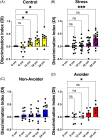Conditioned place avoidance is associated with a distinct hippocampal phenotype, partly preserved pattern separation, and reduced reactive oxygen species production after stress
- PMID: 36807494
- PMCID: PMC10067435
- DOI: 10.1111/gbb.12840
Conditioned place avoidance is associated with a distinct hippocampal phenotype, partly preserved pattern separation, and reduced reactive oxygen species production after stress
Abstract
Stress is associated with contextual memory deficits, which may mediate avoidance of trauma-associated contexts in posttraumatic stress disorder. These deficits may emerge from impaired pattern separation, the independent representation of similar experiences by the dentate gyrus-Cornu Ammonis 3 (DG-CA3) circuit of the dorsal hippocampus, which allows for appropriate behavioral responses to specific environmental stimuli. Neurogenesis in the DG is controlled by mitochondrial reactive oxygen species (ROS) production, and may contribute to pattern separation. In Experiment 1, we performed RNA sequencing of the dorsal hippocampus 16 days after stress in rats that either develop conditioned place avoidance to a predator urine-associated context (Avoiders), or do not (Non-Avoiders). Weighted genome correlational network analysis showed that increased expression of oxidative phosphorylation-associated gene transcripts and decreased expression of gene transcripts for axon guidance and insulin signaling were associated with avoidance behavior. Based on these data, in Experiment 2, we hypothesized that Avoiders would exhibit elevated hippocampal (HPC) ROS production and degraded object pattern separation (OPS) compared with Nonavoiders. Stress impaired pattern separation performance in Non-Avoider and Avoider rats compared with nonstressed Controls, but surprisingly, Avoiders exhibited partly preserved pattern separation performance and significantly lower ROS production compared with Non-Avoiders. Lower ROS production was associated with better OPS performance in Stressed rats, but ROS production was not associated with OPS performance in Controls. These results suggest a strong negative association between HPC ROS production and pattern separation after stress, and that stress effects on these outcome variables may be associated with avoidance of a stress-paired context.
Keywords: DG-CA3; RNA sequencing (RNAseq); conditioned place avoidance (CPA); dentate gyrus; differentially expressed genes (DEGs); dorsal hippocampus; electron paramagnetic resonance spectroscopy (EPR); electron spin resonance spectroscopy (ESR); hippocampus (HPC); maximal respiratory capacity; metabolism; mitochondria; mitochondrial spare respiratory capacity; object pattern separation (OPS); oxygen consumption rate (OCR); predator odor; reactive oxygen species (ROS); seahorse extracellular flux analysis (SEFA); stress; weighted genome correlational network analysis (WGCNA).
© 2023 The Authors. Genes, Brain and Behavior published by International Behavioural and Neural Genetics Society and John Wiley & Sons Ltd.
Conflict of interest statement
D. Parker Kelley, Lucas Albrechet‐Souza, Shealan Cruise, Rajani Maiya, Aspasia Destouni, Siva S. V. P. Sakamuri, Alexander Duplooy, Meghan Hibicke, Prasad Katakam, and Joseph Francis
Figures







References
-
- Association A.P . Diagnostic and Statistical Manual of Mental Disorders DSM‐5. 2013.
-
- Martinelli C, Shergill SS. Clarifying the role of pattern separation in schizophrenia: the role of recognition and visual discrimination deficits. Schizophr Res. 2015;166:328‐333. - PubMed
Publication types
MeSH terms
Substances
Grants and funding
- NS114286/NS/NINDS NIH HHS/United States
- R01 HL157519/HL/NHLBI NIH HHS/United States
- 1RO1HL157519-01A1/HL/NHLBI NIH HHS/United States
- AG074489/AG/NIA NIH HHS/United States
- R01AA026531/AA/NIAAA NIH HHS/United States
- R01 AA026531/AA/NIAAA NIH HHS/United States
- R01 AG074489/AG/NIA NIH HHS/United States
- RO1HL147133/HL/NHLBI NIH HHS/United States
- R01 NS114286/NS/NINDS NIH HHS/United States
- R01 AA023305/AA/NIAAA NIH HHS/United States
- R01AA023305/AA/NIAAA NIH HHS/United States
- R01 HL147133/HL/NHLBI NIH HHS/United States
LinkOut - more resources
Full Text Sources
Medical
Miscellaneous

